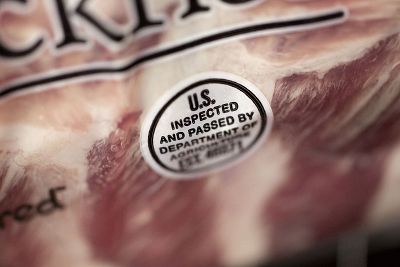The new rule also allows plants to run their processing lines as fast as they like.
The Trump administration will allow pork plants to reduce the number of Department of Agriculture inspectors assigned to them and run their slaughter lines without any speed limit under a new rule intended to modernize an antiquated inspection system. But the changes have alarmed consumer advocates who believe the rule will make food less safe and endanger workers.
The new rule will let factory workers, rather than USDA inspectors, remove unsuitable carcasses and trim defects in plants that opt into the new inspection system. USDA inspectors will still examine the carcasses, but they will be stationed farther down the line.
"This regulatory change allows us to ensure food safety while eliminating outdated rules and allowing for companies to innovate," Agriculture Secretary Sonny Perdue said in a statement Tuesday unveiling the new rule.
The USDA says that the rule is the first time in more than 50 years that pork inspections will be modernized, making food safer by focusing inspectors' attention on more targeted safety checks rather than visual line inspections. The agency estimates that the change will reduce the total number of USDA inspectors at pork plants by 40 percent, saving about $8.7 million a year.
Industry groups cheered the USDA's announcement, which comes more than 20 years after the federal government launched a pilot program to test the new system.
"We applaud the USDA for introducing a new inspection system that incentivizes investment in new technologies while ensuring a safe supply of wholesome American pork," David Herring, president of the National Pork Producers Council, said in a statement.
But consumer advocates fear that factory workers will not be as well trained or independent as USDA inspectors, and that they could miss critical signs of disease and contamination, endangering the public.
"This rule puts industry profits ahead of public health," said Thomas Gremillion, director of food policy for the Consumer Federation of America, an advocacy group. He called the rule "a recipe for food safety disaster."
The USDA insists that public health will continue to be protected, as agency inspectors will oversee the work of factory employees. In the pilot program, the agency said, USDA inspectors conducted more checks for contaminants than under the old system.
The Obama administration made a similar change to modernize poultry inspections in 2014, but decided against raising the maximum line speed limit after an outcry from worker safety advocates. The Trump administration, by contrast, is doing away with speed limits altogether in pork plants that participate in the new inspection system.
Debbie Berkowitz, a former Labor Department official under the Obama administration, says the change will harm workers who are already laboring under dangerous conditions in traditional plants, which are currently allowed to process up to 1,106 hogs per hour.
The rule "will lead to an increase in serious and often crippling injuries to tens of thousands of slaughterhouse workers, who already endure exceedingly harsh conditions to provide cheap pork to American consumers," Berkowitz said in a statement. "The Trump administration is rigging the rules against our nation's packinghouse workers and sacrificing their health to benefit narrow corporate interests."
Advocates also criticized the USDA for moving forward with the rule amid an ongoing investigation by the agency's inspector general, who is examining whether the USDA used faulty data and hid information about the new rule's impact on worker safety.
The USDA is currently developing similar changes to beef inspections.












